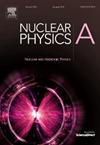26Si(p,γ)27P天体物理反应速率的再评价
IF 1.7
4区 物理与天体物理
Q2 PHYSICS, NUCLEAR
引用次数: 0
摘要
在这项工作中,我们重新评估了26Si(p,γ)27P过程的反应速率,原因是之前的研究中关于关键参数(如Γγ, Γp, ωγ)和零能量S(0)的S -因子的差异。利用NuShellX代码和新开发的USDCm相互作用[20],我们进行了壳层模型计算,以再现能级并计算各种状态的光谱因子。利用壳模型计算确定了3/2+和5/2+态的伽马宽度(Γγ)值。此外,我们使用WSPOT代码分析散射截面和相移来计算质子宽度(Γp)值。然后,我们分别计算了3/2+和5/2+状态的谐振强度(ωγ)值。在这里,我们利用RADCAP代码来计算S -因子在零能量,S(0)。最后,我们计算了0.1 - 2gk温度范围内的反应速率。我们的研究结果提供了对26Si(p,γ)27P反应速率的精细理解,解决了先前研究中的不一致之处。本文章由计算机程序翻译,如有差异,请以英文原文为准。
Re-evaluation of the 26Si(p,γ)27P astrophysical reaction rate
In this work, we re-evaluate the reaction rate for the 26Si(p,γ)27P process, motivated by discrepancies in previous studies regarding key parameters such as , , ωγ, and the S - factor at zero energy, S(0). Using the NuShellX code with the newly developed USDCm interaction [20], we performed shell model calculations to reproduce energy levels and calculate spectroscopic factors for various states. The gamma width () values for the 3/2+ and 5/2+ states were determined using shell model calculations. Additionally, we employed the WSPOT code to analyze scattering cross-sections and phase shifts to compute the proton width () values. After that, we have calculated the resonance strength (ωγ) values for 3/2+ and 5/2+ states respectively. Here, we have utilized the RADCAP code to calculate the S - factor at zero energy, S(0). Finally, we computed the reaction rates across a temperature range of 0.1 - 2 GK. Our results provide a refined understanding of the 26Si(p,γ)27P reaction rate, addressing inconsistencies in previous studies.
求助全文
通过发布文献求助,成功后即可免费获取论文全文。
去求助
来源期刊

Nuclear Physics A
物理-物理:核物理
CiteScore
3.60
自引率
7.10%
发文量
113
审稿时长
61 days
期刊介绍:
Nuclear Physics A focuses on the domain of nuclear and hadronic physics and includes the following subsections: Nuclear Structure and Dynamics; Intermediate and High Energy Heavy Ion Physics; Hadronic Physics; Electromagnetic and Weak Interactions; Nuclear Astrophysics. The emphasis is on original research papers. A number of carefully selected and reviewed conference proceedings are published as an integral part of the journal.
 求助内容:
求助内容: 应助结果提醒方式:
应助结果提醒方式:


